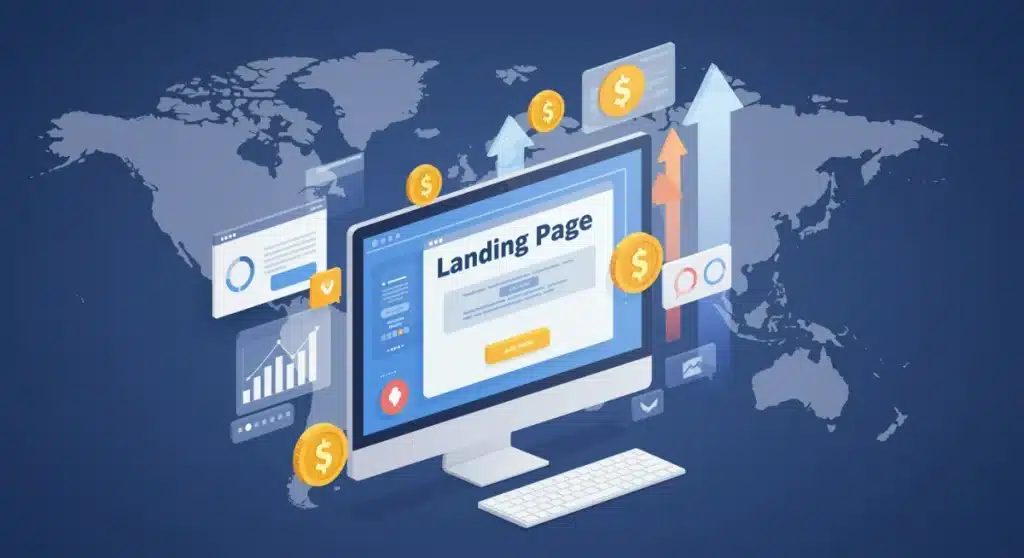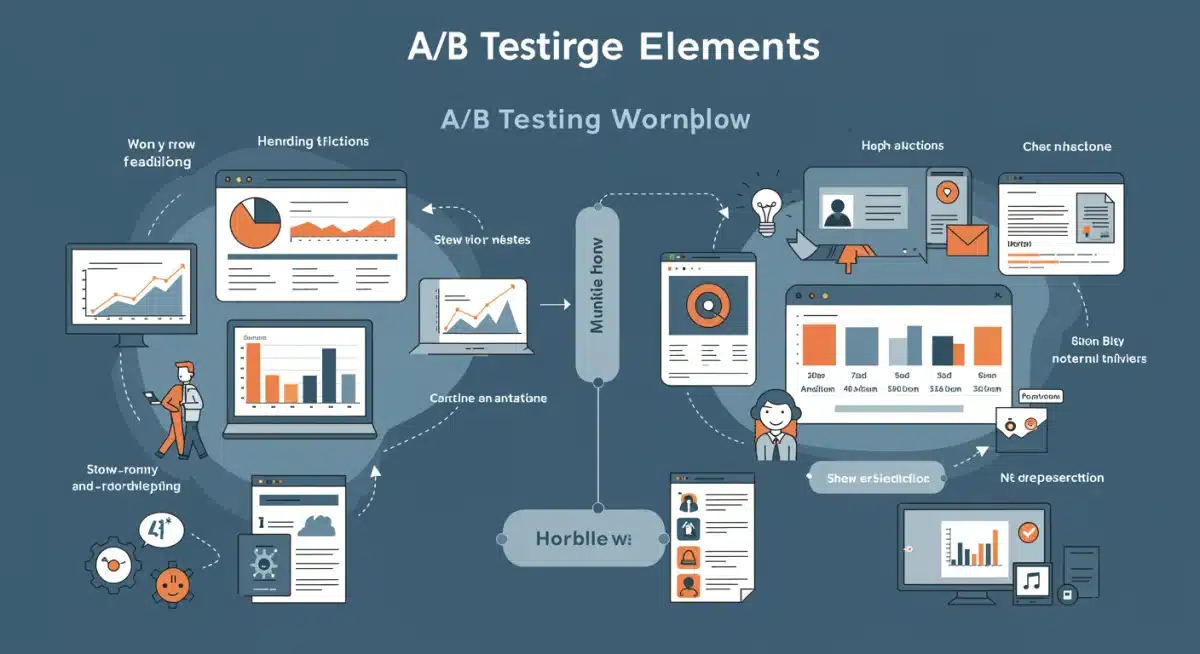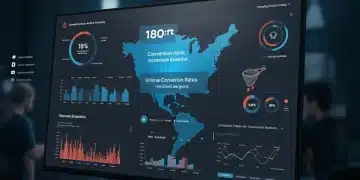Crafting High-Converting Landing Pages: 2025 US Digital Campaigns Checklist

Crafting High-Converting Landing Pages: A Checklist for 2025 US Digital Campaigns (PRACTICAL SOLUTIONS) is now paramount for maximizing ROI, requiring a strategic focus on user experience, compelling content, and advanced optimization techniques to meet evolving market demands.
As the digital landscape rapidly evolves, the imperative to master Crafting High-Converting Landing Pages: A Checklist for 2025 US Digital Campaigns (PRACTICAL SOLUTIONS) has never been more critical. Businesses across the United States are currently facing heightened competition and sophisticated consumer expectations. This news brief provides an immediate look into the essential strategies and tactical adjustments necessary to ensure your landing pages aren’t just seen, but convert visitors into valuable leads and customers.
The Evolving Landscape of US Digital Campaigns for 2025
The digital marketing arena in the US is undergoing significant shifts as of early 2025, driven by advancements in AI, changes in consumer privacy regulations, and an increased demand for personalized experiences. Marketers are now tasked with navigating a complex environment where generic approaches yield diminishing returns. The focus has decisively shifted towards hyper-targeted content and seamless user journeys, making the landing page a pivotal touchpoint in the conversion funnel.
Recent reports from leading analytics firms indicate a rising trend in mobile-first indexing and voice search optimization, directly impacting how landing pages must be structured and presented. Furthermore, with data privacy becoming a cornerstone of consumer trust, transparent data collection and usage policies on landing pages are no longer optional but mandatory for compliance and credibility. Brands failing to adapt risk losing significant market share and trust among their target audiences.
Key Technological Integrations
- AI-Powered Personalization: Implementing AI to dynamically adjust landing page content based on user behavior and demographics.
- Voice Search Optimization: Designing pages with natural language queries in mind to capture voice search traffic.
- Enhanced Analytics Tools: Leveraging advanced analytics to gain deeper insights into user engagement and conversion paths.
Understanding Your Target Audience: The Foundation of Conversion
Effective Crafting High-Converting Landing Pages: A Checklist for 2025 US Digital Campaigns (PRACTICAL SOLUTIONS) begins with an exhaustive understanding of your target audience. In 2025, this involves more than just demographic data; it necessitates delving into psychographics, behavioral patterns, and their specific pain points. US consumers are increasingly discerning, and a one-size-fits-all approach to landing page content will inevitably fall short. Developing detailed buyer personas is no longer a best practice; it’s a fundamental requirement for any successful digital campaign.
Audience insights, often derived from a blend of first-party data and sophisticated market research, inform every aspect of landing page design, from headline creation to call-to-action phrasing. This deep understanding enables marketers to craft messages that resonate directly with the user’s needs and aspirations, significantly increasing the likelihood of conversion. Without this foundational step, even the most aesthetically pleasing landing page will struggle to perform.
Leveraging Data for Persona Development
Utilizing comprehensive data streams is crucial for building robust buyer personas that accurately reflect your target audience. This includes analyzing website traffic, social media engagement, customer feedback, and sales data. The goal is to uncover not just who your audience is, but why they make decisions and what motivates their actions.
- Behavioral Analytics: Tracking user interactions, scroll depth, and click-through rates to understand engagement.
- Customer Feedback Loops: Implementing surveys, polls, and direct interviews to gather qualitative insights.
- Demographic and Psychographic Profiling: Combining traditional data with psychological traits and lifestyle choices.
Compelling Content and Messaging Strategies
The core of any high-converting landing page lies in its content and messaging. For 2025 US digital campaigns, this means moving beyond generic sales copy to deliver value-driven, persuasive narratives that address specific user needs. Headlines must be immediately engaging, clearly articulating the unique selling proposition. The body copy should be concise, scannable, and focused on benefits rather than just features, guiding the user towards the desired action with clarity and confidence.
Visual content, including high-quality images and videos, plays an increasingly vital role in capturing attention and conveying complex information quickly. Testimonials and social proof are also non-negotiable elements, building trust and credibility with skeptical audiences. As reported by recent industry benchmarks, landing pages that effectively integrate these elements see significantly higher conversion rates compared to those that rely solely on text.


Crafting Irresistible Calls-to-Action (CTAs)
The Call-to-Action (CTA) is the most critical element on a landing page, directly influencing whether a visitor converts. For 2025, CTAs must be more than just buttons; they need to be compelling invitations. They should be prominent, use action-oriented language, and clearly state the benefit of clicking. Personalization of CTAs, where the text changes based on user behavior or demographic data, is emerging as a powerful optimization technique.
- Clarity and Urgency: Use phrases like “Get Your Free Guide Now” or “Claim Your Discount Today.”
- Visual Prominence: Ensure CTAs stand out with contrasting colors and sufficient white space.
- Benefit-Oriented Language: Focus on what the user gains, not just what they need to do.
Optimizing User Experience and Design
User experience (UX) and design are paramount in Crafting High-Converting Landing Pages: A Checklist for 2025 US Digital Campaigns (PRACTICAL SOLUTIONS). A cluttered or confusing layout can deter visitors, regardless of the quality of your content. Pages must be intuitively designed, guiding the user’s eye naturally through the information and towards the CTA. Mobile responsiveness is no longer an added benefit but a fundamental requirement, given the prevalence of smartphone usage across the US.
Loading speed is another critical factor; slow-loading pages lead to high bounce rates and negatively impact SEO. Minimizing distractions, such as excessive navigation menus or pop-ups, ensures that the user remains focused on the primary objective of the page. The aesthetic appeal of the landing page also contributes significantly to perceived trustworthiness and professionalism, directly influencing conversion rates.
Key Design Principles for 2025
Adhering to modern design principles ensures your landing pages are not only visually appealing but also highly functional. Simplicity, clarity, and consistency are the hallmarks of effective landing page design, minimizing cognitive load for the user.
- Clean Layouts: Employ ample white space to improve readability and focus.
- Intuitive Navigation: Streamline the user journey, making the next step obvious.
- Visual Hierarchy: Use size, color, and placement to guide attention to key elements.
Technical SEO and Performance Enhancements
Beyond content and design, the technical backbone of your landing pages significantly impacts their performance in 2025 US digital campaigns. Search Engine Optimization (SEO) is evolving, with Google and other search engines placing increasing emphasis on page experience metrics. This includes core web vitals, mobile-friendliness, and secure browsing. A technically optimized landing page is more likely to rank higher in search results, driving organic traffic and increasing visibility.
Regular auditing of your landing page’s technical performance is crucial. This involves checking for broken links, optimizing image sizes, ensuring fast server response times, and implementing structured data where appropriate. Furthermore, secure connections (HTTPS) are non-negotiable for building trust and protecting user data, which search engines now heavily penalize if absent. Neglecting these technical aspects can undermine even the best-designed and most compelling landing pages.
Essential Technical Optimizations
- Core Web Vitals Optimization: Focusing on Largest Contentful Paint (LCP), First Input Delay (FID), and Cumulative Layout Shift (CLS).
- Mobile-First Indexing Compliance: Ensuring your page is optimized for mobile devices above all else.
- Schema Markup Implementation: Using structured data to help search engines understand your content better.
A/B Testing and Continuous Optimization
The journey of Crafting High-Converting Landing Pages: A Checklist for 2025 US Digital Campaigns (PRACTICAL SOLUTIONS) is iterative, demanding continuous testing and optimization. What works today may not work tomorrow, as consumer behaviors and market trends shift. A/B testing, also known as split testing, is an indispensable tool for identifying the most effective elements of your landing page. This involves creating two versions of a page (A and B) with a single variable changed and then directing traffic to both to see which performs better.
Beyond A/B testing, multivariate testing allows for simultaneous testing of multiple elements, providing deeper insights into how different combinations impact conversion rates. The insights gained from these tests should inform ongoing adjustments to headlines, CTAs, imagery, form fields, and even overall layout. This data-driven approach ensures that your landing pages are always performing at their peak potential, adapting to the dynamic digital environment.
Key Metrics for Landing Page Performance
Monitoring the right metrics is essential for effective optimization. These metrics provide a clear picture of how your landing pages are performing and where improvements can be made. Focus on metrics that directly correlate with your campaign goals.
- Conversion Rate: The percentage of visitors who complete the desired action.
- Bounce Rate: The percentage of visitors who leave the page without interacting.
- Time on Page: How long users spend engaging with your content.
- Cost Per Acquisition (CPA): The cost incurred to acquire a new customer or lead.
| Key Point | Brief Description |
|---|---|
| Audience Understanding | Deep dive into psychographics and behavior for targeted content. |
| Compelling Content | Value-driven narratives, strong CTAs, and visual engagement. |
| UX & Design Optimization | Intuitive layouts, mobile responsiveness, and fast loading speeds. |
| Technical SEO | Core Web Vitals, mobile-first indexing, and secure browsing. |
Frequently Asked Questions About Landing Page Optimization
The most critical element is a clear, benefit-driven Call-to-Action (CTA) that guides the user towards the desired conversion. This must be supported by compelling, value-oriented content and an intuitive user experience to maximize effectiveness.
Privacy regulations like CCPA and evolving state laws necessitate transparent data collection notices, clear consent mechanisms, and secure handling of user information. Landing pages must clearly communicate privacy policies to build user trust and ensure compliance.
Mobile-first optimization is crucial because a significant portion of US digital traffic originates from mobile devices. Search engines prioritize mobile-friendly sites for ranking, and a poor mobile experience leads to high bounce rates and lost conversions.
AI plays a significant role in personalizing content, dynamically adjusting page elements based on user behavior, and optimizing ad targeting. AI-powered analytics also provide deeper insights for continuous improvement and predictive modeling.
Landing pages should be continuously A/B tested, not just periodically. The digital landscape and consumer preferences are constantly changing, making ongoing iterative testing essential to maintain peak performance and adapt to new trends and insights.
Looking Ahead: The Future of Landing Page Conversions
The critical focus on Crafting High-Converting Landing Pages: A Checklist for 2025 US Digital Campaigns (PRACTICAL SOLUTIONS) is set to intensify. Marketers must remain agile, continuously integrating new technologies and adapting to evolving consumer expectations and regulatory frameworks. The future will likely see even greater emphasis on hyper-personalization, interactive elements, and AI-driven predictive analytics to anticipate user needs. Brands that prioritize a data-driven, user-centric approach to their landing pages will be best positioned to capture market share and achieve significant ROI in the competitive 2025 digital landscape and beyond. Staying informed on emerging trends and committing to continuous optimization will be paramount for sustained success.





